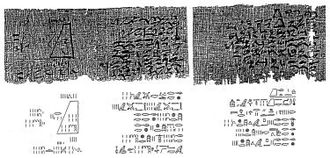MATHEMATICS 28
Egyptian[edit]
Egyptian mathematics refers to mathematics written in the Egyptian language. From the Hellenistic period, Greekreplaced Egyptian as the written language of Egyptian scholars. Mathematical study in Egypt later continued under the Arab Empire as part of Islamic mathematics, when Arabic became the written language of Egyptian scholars.
The most extensive Egyptian mathematical text is the Rhind papyrus (sometimes also called the Ahmes Papyrus after its author), dated to c. 1650 BC but likely a copy of an older document from the Middle Kingdom of about 2000–1800 BC.[26] It is an instruction manual for students in arithmetic and geometry. In addition to giving area formulas and methods for multiplication, division and working with unit fractions, it also contains evidence of other mathematical knowledge,[27] including composite and prime numbers; arithmetic, geometric and harmonic means; and simplistic understandings of both the Sieve of Eratosthenes and perfect number theory (namely, that of the number 6).[28] It also shows how to solve first order linear equations[29] as well as arithmetic and geometric series.[30]
Another significant Egyptian mathematical text is the Moscow papyrus, also from the Middle Kingdom period, dated to c. 1890 BC.[31] It consists of what are today called word problems or story problems, which were apparently intended as entertainment. One problem is considered to be of particular importance because it gives a method for finding the volume of a frustum (truncated pyramid).
Finally, the Berlin Papyrus 6619 (c. 1800 BC) shows that ancient Egyptians could solve a second-order algebraic equation.[32]

No comments:
Post a Comment